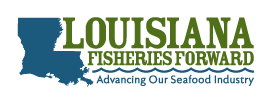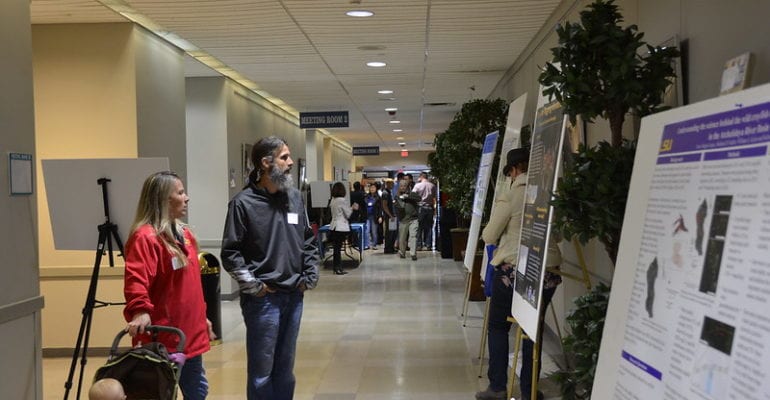Following is a list of the poster abstracts to be displayed at the LA Fisheries Forward Summit on March 11, 2020 at the Pontchartrain Center in Kenner. This free event for the commercial seafood industry features the latest updates on regulations, equipment and gear, safety, cold chain management, education, value-added processing, and more.
How different populations of oysters (Crassostrea virginica) respond to different environmental salinities.
Lauren Swam, School of Renewable Natural Resources, LSU AgCenter
Megan La Peyre, USGS, Louisiana Fish and Wildlife Cooperative Research Unit, School of Renewable Natural Resources, Louisiana State University Agricultural Center
Jerome La Peyre, School of Animal Sciences, LSU AgCenter
Brian Callam, School of Renewable Natural Resources, LSU AgCenter; Louisiana Sea Grant College Program
In Louisiana, exposure of eastern oyster (Crassostrea virginica) populations to decreasing salinities and increasing environmental fluctuations may impact sustainability and resilience. Across Louisiana, oysters exist in locations characterized by high freshwater inflow and likely experience extended low salinities, suggesting some uniquely adapted populations. These populations may provide an opportunity to develop low salinity tolerant stock for aquaculture, and restoration activities. This research evaluates the growth, mortality and disease resistance of four such oyster populations by growing progeny of each population in both a moderately high (Grand Isle, LA) and low (LUMCON, LA) salinity environment for 12 months. Growth and mortality will be assessed monthly and will be later analyzed with respect to conditions at the populations’ sites of origin. As oysters along Louisiana’s coast experience increasing freshwater due to diversions and other processes, identifying populations uniquely tolerant to decreased salinity will be valuable in supporting continued oyster production and restoration.
The Louisiana Diet: investigating oyster food webs in our changing estuaries
Julia Sweet, UL Lafayette
Sandra Casas, LSU AgCenter
Jerome La Peyre, LSU AgCenter
Megan La Peyre, LSU AgCenter, USGS
Julie Lively, Louisiana Sea Grant, LSU School of Renewable Natural Resources
Beth Stauffer, UL Lafayette
Two components of the Louisiana Coastal Master Plan include large-scale river engineering and oyster reef restoration. Increased freshwater input will decrease salinities in LA estuaries as temperatures in the Gulf of Mexico continue to increase. While oysters themselves may survive in warmer, less salty environments, the quality of their food source – microscopic algae called phytoplankton – is also likely to change. Our research will determine phytoplankton composition and food quality in two Louisiana estuaries (Terrebonne and Barataria Bays) throughout the year. In the laboratory, two phases of feeding experiments will investigate how changes in food options will impact oyster filtration, and tease apart the effects of changing food versus environmental shifts. Results will provide valuable information on how food quality and quantity that affect oyster growth and condition are expected to change in the coming years and will help inform choices for those invested in oyster aquaculture, stock management and restoration.
Estuary freshening: How do cyanobacteria affect oyster feeding?
Andrea Jaeffe, UL Lafayette
Sandra Casas, LSU AgCenter
Jerome La Peyre, LSU AgCenter
Megan La Peyre, USGS, Louisiana Fish and Wildlife Cooperative Research Unit
Beth Stauffer, UL Lafayette
Restoration activities planned in the Louisiana Coastal Master Plan are expected to shift salinity regimes in coastal estuaries. A reduction in salinity due to large-scale river engineering will change estuarine phytoplankton communities. This is of concern as phytoplankton support ecologically and economically important species including the eastern oyster (Crassostrea virginica). Lower salinities support growth of cyanobacteria, a potentially toxic and poor food source. To investigate what this shift in diet means for oysters, experiments were conducted using natural phytoplankton communities from Terrebonne Bay, a non-toxic strain of freshwater cyanobacteria (Microcystis aeruginosa), and populations of oysters. Preliminary results suggest the presence of cyanobacteria changed the particle size ingested by oysters, but this change depended on the dominant size ranges present in the natural phytoplankton community. Therefore, it is important to better understand this variability in natural phytoplankton communities across LA estuaries and resolve what shifts in diet mean for oyster growth.
Environmental DNA as a tool to survey the fish communities of artificial reefs in Lake Pontchartrain
Megan Ryba, Southeastern Louisiana University
Kyle R. Pillar, Southeastern Louisiana University
Environmental DNA (eDNA) is a non-invasive technique that allows biologists to take water samples from the environment and use genetic techniques to determine the presence of a species based on their DNA. This approach is beneficial for habitats that can be difficult to sample. Lake Pontchartrain has a high level of turbidity, making fish sampling on artificial reefs difficult. Sixteen artificial reefs have been deployed, but the success of the reefs is relatively unknown. Therefore, the goal of this study was to utilize eDNA to examine fish community diversity of six artificial reefs and their paired controls in Lake Pontchartrain. The surveyed reefs consisted of three concrete reef ball reefs and three concrete/limestone rubble reefs that ranged in deployment age from 2001 to 2016. Results indicate significant differences in the composition of fish communities among controls and artificial reefs and significant differences among communities based on reef age and material.
Flood Hazard Risk Assessment
Ehab S. Gnan, Bert S. Turner Department of Construction Management, Louisiana State University
Carol Friedland, Bert S. Turner Department of Construction Management, Louisiana State University
Monica Farris, Department of Planning and Urban Studies, The University of New Orleans
Robert Rohli, Department of Oceanography & Coastal Sciences, Louisiana State University
Yongcheol Lee, Bert S. Turner Department of Construction Management, Louisiana State University
Arash Taghinezhad Bert S. Turner Department of Construction Management, Louisiana State University
Rubayet Bin Mostafiz, Department of Oceanography & Coastal Sciences, Louisiana State University
Yamini Kodavatiganti, Bert S. Turner Department of Construction Management, Louisiana State University
Building Land in Coastal Louisiana: Expert Recommendations for Operating a Successful Sediment Diversion that Balances Ecosystem and Community Needs
Natalie Snider, Environmental Defense Fund, Washington DC, USA
Rachel Rhode, Environmental Defense Fund, Washington DC, USA
Rex Caffey, Louisiana State University, Baton Rouge, LA
James Cowan, Louisiana State University, Baton Rouge, LA
Dubravko Justic, Louisiana State University, Baton Rouge, LA
Alexander Kolker, Louisiana Universities Marine Consortium, Chauvin, LA; Department of Earth and Environmental Sciences, Tulane University, New Orleans, LA
Shirley Laska, University of New Orleans, New Orleans, LA; The Lowlander Center, Gray, LA
Alex McCorquodale, University of New Orleans, New Orleans, LA
Earl Melancon, Department of Biological Sciences, Nicholls State University, Thibodaux, LA
John Nyman, Louisiana State University, Baton Rouge, LA
Robert Twilley, Louisiana State University, Baton Rouge, LA
Jenneke Visser, Institute for Coastal and Water Research, University of Louisiana at Lafayette, Lafayette, LA
John White, Louisiana State University, Baton Rouge, LA
James Wilkins, Louisiana State University, Baton Rouge, LA
The Environmental Defense Fund (EDF) and Restore the Mississippi River Delta formed an interdisciplinary Sediment Diversion Operations Expert Working Group (WG) to tackle complex topics related to the operations of a diversion, specifically the Mid-Barataria Sediment Diversion. The WG developed a series of recommendations such as operate to build and sustain land, develop secondary objectives to consider the needs of the ecosystem and the people, make operation plans living documents with monitoring and adaptive management, identify impacts to communities and industries and communicate them properly, monitor before and after construction, and define a clear governance structure. The WG also provided some key operational strategies to be considered. This includes using the higher river flows and sediment loads strategically, working with the geology of the receiving basin to build land, maintaining water quality and wetland health, and balancing the needs of fish and wildlife species.





